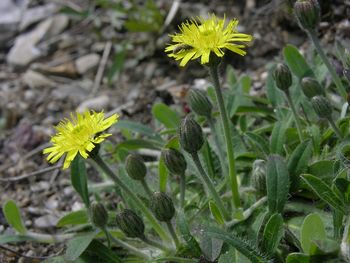Mouse-ear hawkweed
Other Names : Hieracium pilosella, Pilosella officinarum, Piloselle, Kleines Habichtskraut, Muizenoor, Épervière piloselle, Oreille de souris, Oreille de rat, Piloselle de rat, Herbe à l'épervier, Veluette.
Common in Europe, North Africa and Asia, mouse-ear hawkweed is a tiny herbaceous plant with crawling shoots, or runners. Its elongated, oval leaves are coated in white hairs and form a rosette around the base of the plant. From May to September, when the plant is in bloom, dandelion-like flowers appear at the tips of the almost leafless stems.
Contents
Special Precautions
it has a mildly psychoactive effect, which is compared to that of cannabis and is said to start working from about one gram when smoked. Since there are not many studies and testimonials, it is not known why it has the effects and what the long-term risks are.
Constituents
- All parts of the plant contain umbelliferone, a coumarin, which has an antibiotic effect, flavonoids, which are diuretic, and phenols substances with antiseptic and antiinflammatory actions.
- The plant produces triterpenoids, mainly taraxasterol, but also the 4,4-dimethyl phytosterols alpha- and beta-amyrin, taraxerol, and fern-7en-3beta-ol.
Properties
The pharmacology modern recognizes the following properties: anti-infectious, detoxifying, astringent, cholagogue, appetizing, purifying, vulnerary, detergent and diuretic. It contains in particular umbelliferone which has antibiotic , antioxidant , anti-inflammatory , anti-hyperglycemic and anti-tumor properties.
Health Benefits and Uses
In the Middle Ages, the hawkweed was used to predict the cure or death of patients. The holy abbess Hildegard was the first to mention the plant in the XIIth century .
- Since then, its medicinal use to strengthen sight and heal wounds has been preserved in the countryside.
- Its rosette of raw edible leaves was dried and used as a remedy for respiratory ailments (asthma, bronchitis), liver and stomach problems.
- It was also used as a poultice against bruises
- used for mild mouth and throat infections and for mild diarrhea in children and the elderly.
- The fresh juice reduced human and animal brucellosis , as well as Maltese fever.
- In powder form, its astringency was used as an antihemorrhagic, especially for nosebleeds.
- Diuretic : French studies in 1999 demonstrated the diuretic effects of the plant's flavonoids. Because it can help the body to eliminate excess fluid and waste, the plant is an effective treatment for swelling caused by water retention, especially in the legs and lower part of the body.
- Anti-inflammatory and antispasmodic properties. It is sometimes applied to wounds, and used to treat respiratory complaints such as asthma and bronchitis, as well as to ease inflammation in the kidneys and urinary tract.
- Umbelliferone is known to help stimulate the flow of bile from the gall bladder, helping to keep the digestive system healthy, and research has shown that it also has an antibiotic effect. And in 1993, American scientists discovered that umbelliferone, as well as other coumarin derivatives, can help to fight off the HIV virus and it is thought that this ability might be harnessed for combating other types of viral infection.
- In Denmark the leaves are smoked like a joint.
Main Combinations
- Overweight with normal appetite : Green Tea + Orthosiphon (or Pilosella officinarum)
- Overweight with Circulatory Problems : Green Tea + Hamamelis + Pilosella officinarum + Wine Pomace
- Water Retention : Cherry Stems + Mouse-ear hawkweed + Birch
